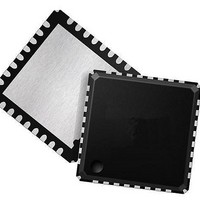LAN88710_samples SMSC, LAN88710_samples Datasheet - Page 32

LAN88710_samples
Manufacturer Part Number
LAN88710_samples
Description
Ethernet ICs MII/RMII 10/100 Automot Transceiver
Manufacturer
SMSC
Datasheet
1.LAN88710BM_SAMPLES.pdf
(80 pages)
Specifications of LAN88710_samples
Ethernet Connection Type
10BASE-T, 100BASE-TX
Minimum Operating Temperature
- 40 C
Mounting Style
SMD/SMT
Product
Ethernet Transceivers
Standard Supported
IEEE802.3, IEEE802.3u
Supply Voltage (max)
3.6 V
Supply Voltage (min)
1.6 V
Maximum Operating Temperature
+ 85 C
Package / Case
QFN-32
Lead Free Status / RoHS Status
Lead free / RoHS Compliant
Revision 1.1 (05-26-10)
3.4.2
3.4.2.1
3.4.2.2
RMII
The device supports the low pin count Reduced Media Independent Interface (RMII) intended for use
between Ethernet transceivers and switch ASICs. Under IEEE 802.3, an MII comprised of 16 pins for
data and control is defined. In devices incorporating many MACs or transceiver interfaces such as
switches, the number of pins can add significant cost as the port counts increase. RMII reduces this
pin count while retaining a management interface (MDIO/MDC) that is identical to MII.
The RMII interface has the following characteristics:
The RMII includes the following interface signals (1 optional):
CRS_DV - Carrier Sense/Receive Data Valid
The CRS_DV is asserted by the device when the receive medium is non-idle. CRS_DV is asserted
asynchronously on detection of carrier due to the criteria relevant to the operating mode. In 10BASE-
T mode when squelch is passed, or in 100BASE-X mode when 2 non-contiguous zeroes in 10 bits are
detected, the carrier is said to be detected.
Loss of carrier shall result in the deassertion of CRS_DV synchronous to the cycle of REF_CLK which
presents the first di-bit of a nibble onto RXD[1:0] (i.e. CRS_DV is deasserted only on nibble
boundaries). If the device has additional bits to be presented on RXD[1:0] following the initial
deassertion of CRS_DV, then the device shall assert CRS_DV on cycles of REF_CLK which present
the second di-bit of each nibble and de-assert CRS_DV on cycles of REF_CLK which present the first
di-bit of a nibble. The result is, starting on nibble boundaries, CRS_DV toggles at 25 MHz in 100 Mbps
mode and 2.5 MHz in 10 Mbps mode when CRS ends before RXDV (i.e. the FIFO still has bits to
transfer when the carrier event ends). Therefore, the MAC can accurately recover RXDV and CRS.
During a false carrier event, CRS_DV shall remain asserted for the duration of carrier activity. The data
on RXD[1:0] is considered valid once CRS_DV is asserted. However, since the assertion of CRS_DV
is asynchronous relative to REF_CLK, the data on RXD[1:0] shall be “00” until proper receive signal
decoding takes place.
Reference Clock (REF_CLK)
The RMII REF_CLK is a continuous clock that provides the timing reference for CRS_DV, RXD[1:0],
TXEN, TXD[1:0] and RXER. The device uses REF_CLK as the network clock such that no buffering
is required on the transmit data path. However, on the receive data path, the receiver recovers the
clock from the incoming data stream, and the device uses elasticity buffering to accommodate for
differences between the recovered clock and the local REF_CLK.
It is capable of supporting 10 Mbps and 100 Mbps data rates
A single clock reference is used for both transmit and receive
It provides independent 2-bit (di-bit) wide transmit and receive data paths
It uses LVCMOS signal levels, compatible with common digital CMOS ASIC processes
transmit data - TXD[1:0]
transmit strobe - TXEN
receive data - RXD[1:0]
receive error - RXER (Optional)
carrier sense - CRS_DV
Reference Clock - (RMII references usually define this signal as REF_CLK)
Small Footprint MII/RMII 10/100 Ethernet Transceiver for Automotive Applications
DATASHEET
32
SMSC LAN88710AM/LAN88710BM
Datasheet












